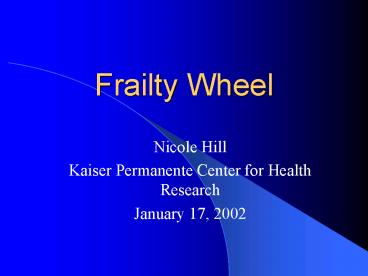Frailty Wheel - PowerPoint PPT Presentation
1 / 16
Title:
Frailty Wheel
Description:
... for Screen Every Elder in Kaiser was started, and the Health ... 2000- The Kaiser Permanente program asked for ways to simplify the screening process. ... – PowerPoint PPT presentation
Number of Views:342
Avg rating:3.0/5.0
Title: Frailty Wheel
1
Frailty Wheel
- Nicole Hill
- Kaiser Permanente Center for Health Research
- January 17, 2002
2
Overview
- Introduction and benefits
- Development
- Findings
- Administration
3
Introduction
- Screening tool for intake workers.
4
Introduction
- Frailty is defined as
- Persons with a high probability of dependency
on others for daily care within the next 12
months.
5
Introduction
- Why identifying the frail elderly is important
for you - At-risk individuals who need a further follow-up
assessment - Reduces the time needed to do a full assessment
by accurately predicting those who may need help
with their care - Helps to screen those persons who may need more
medical services against those who will utilize
less services
6
Benefits
- Scientifically proven to predict frailty-91
accurate - Quick, easy
- Durable and small enough to carry around
- Time saving
7
Development
- 1985- The Center for Health Research began
collecting data from their Social HMO members in
the northwest region of Kaiser Permanente. - 1992- They began a research project to develop
the Frailty Model using 5,903 members of the KPNW
Social HMO in 1990. - 1996- A 45-question survey was completed called
the Health Status Questionnaire.
8
Development
- 1997- SEEK, standing for Screen Every Elder in
Kaiser was started, and the Health Status
Questionnaire was adopted as the health screening
form for all Kaiser members age 65 and up
throughout the country. - 2000- The Kaiser Permanente program asked for
ways to simplify the screening process. - 2001- Frailty Wheel was developed.
9
Development
- During the study
- Clinical classification of frailty was compared
with the statistical data. The statistical
method was able to correctly classify 24 more
people than the clinical method which included
assessment by a social worker. - 10 of the population was classified as frail,
and 90 was classified as non-frail. - Based on these findings, the Research Center
gathered utilization and mortality data from
1990-1998.
10
Findings
- 1990-1998 Utilization(Days/person adjusted for
attrition)
11
Findings
- Decade group mortality rates
12
Findings
- Survival rates, ages 80-84 years
13
Findings
- Survival rates, ages 85 years and older
14
Administration
- Aged-based categories.
- Questions relating to medication assistance,
bathing assistance, and how their health
conditions affect their every day lives. - Detailed instructions provided on the wheel to
guide interviewer (intake worker).
15
Administration
- Accuracy
- Demonstration
- Elizabeth- 77 years old, states that she does
need assistance with her medications but does not
need help with bathing and her health conditions
do not interfere with her daily activities.
Elizabeth is not frail. - George, an 80 year old, states that he does need
medication assistance, but does not need
assistance with his bathing and his health
conditions do not interfere with his daily
activities. George is frail.
16
Administration
Age/Sex Specific Rates of FRAILTY within One
Year for Community-based Population
FEMALE MALE TOTAL AGE RATE () RATE () RATE ()



























![NOTE: To appreciate this presentation [and ensure that it is not a mess], you need Microsoft fonts: PowerPoint PPT Presentation](https://s3.amazonaws.com/images.powershow.com/6577720.th0.jpg?_=20150513116)



